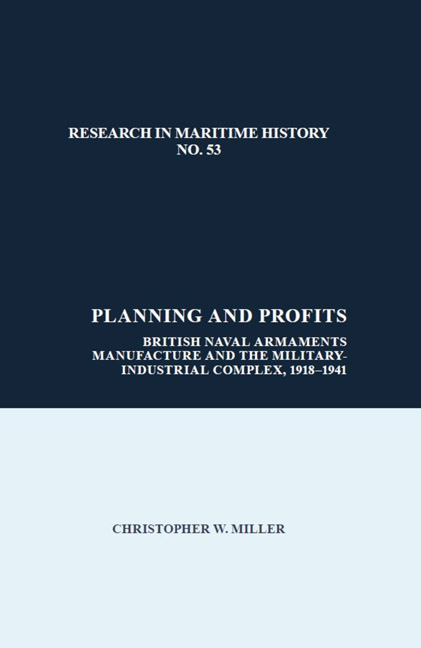 Planning and Profits
Planning and Profits Book contents
- Frontmatter
- Contents
- Acknowledgements
- About the Author
- List of Tables and Figures
- List of Illustrations
- List of Abbreviations
- A Note on Definitions
- Part One Introduction
- 1 “Guilty Men,” Complexes, and Legends
- 2 Structural Changes, from the Ministry of Munitions to the Principal Supply Officers Committee, 1918–1927
- Part Two Industry and the Navy before Manchuria, and the Establishment of the Warshipbuilders’ Committee, 1919–1931
- Part Three The Formation of a National Government, the Far East, and the PSOC Approach to Industry, 1931–1934
- Part Four The Ultimate Potential Enemy and Rearmament Planning, 1934–1936
- Part Five The Inskip Era and War, 1936–1941
- Conclusion and Retrospective
- Appendices
- Bibliography
- Index
2 - Structural Changes, from the Ministry of Munitions to the Principal Supply Officers Committee, 1918–1927
from Part One - Introduction
- Frontmatter
- Contents
- Acknowledgements
- About the Author
- List of Tables and Figures
- List of Illustrations
- List of Abbreviations
- A Note on Definitions
- Part One Introduction
- 1 “Guilty Men,” Complexes, and Legends
- 2 Structural Changes, from the Ministry of Munitions to the Principal Supply Officers Committee, 1918–1927
- Part Two Industry and the Navy before Manchuria, and the Establishment of the Warshipbuilders’ Committee, 1919–1931
- Part Three The Formation of a National Government, the Far East, and the PSOC Approach to Industry, 1931–1934
- Part Four The Ultimate Potential Enemy and Rearmament Planning, 1934–1936
- Part Five The Inskip Era and War, 1936–1941
- Conclusion and Retrospective
- Appendices
- Bibliography
- Index
Summary
The Structure of Industry between the Wars
In truth, apart from 1919 and 1920, when order books were full to replace vessels lost in the war, the period up to 1935 was mostly a struggle for the private shipbuilding industry. The experience of the naval race with Germany before the Great War had created a set of circumstances that could not last forever and certainly could not be matched in the post-war world. The Scottish shipyards on the River Clyde alone launched one-quarter of the world's tonnage in 1913, a figure which owed much to its strong warship sector. Thus, after the war, the Royal Navy possessed a large, young, and expensive fleet, but faced no obvious enemies following the collapse of the Imperial German Navy. Moreover, the British public had been shocked by the horrors of the Great War and now demanded that elected representatives turn their attention to arms limitation and international treaties to ensure there would be no repeat. As such, continuing the high levels of expenditure on the Royal Navy was not a priority for successive British (or other) governments. Industry was left to face the 1920s with only a fraction of the orders it had previously enjoyed.
In private, the government's thinking was guided by the so-called “Ten Year Rule.” Adopted secretly in 1919, the rule assumed that because no major conflict was likely within the next decade there would be no need for a major construction programme. This was renewed annually until 1932, when it was revoked following events in the Far East. But within just five years of its repeal, events in China and later in Germany and Italy set in motion the largest armaments drive in British history, an enterprise in which the Royal Navy played a major part. The problems by 1937 were very different for the British government and industry. After a period of uncertainty when the government feared the political and financial consequences of rearmament, it soon found that it could not move quickly enough: shortages of skills and plant were holding up the effort to put the country's defences in a state of readiness, while severe bottlenecks – large guns were a problem, armour plate another – persisted.
- Type
- Chapter
- Information
- Planning and ProfitsBritish Naval Armaments Manufacture and the Military-Industrial Complex, 1918–1941, pp. 9 - 24Publisher: Liverpool University PressPrint publication year: 2018
